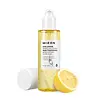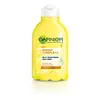What's inside
What's inside
 Key Ingredients
Key Ingredients

 Benefits
Benefits

 Concerns
Concerns

 Ingredients Side-by-side
Ingredients Side-by-side

Water
Skin ConditioningPanthenol
Skin ConditioningAlcohol
AntimicrobialButylene Glycol
HumectantGlycerin
Humectant1,2-Hexanediol
Skin ConditioningCitrus Medica Limonum Fruit Extract
Skin ConditioningSodium Hyaluronate
HumectantPhenyl Trimethicone
Skin ConditioningAcrylates/C10-30 Alkyl Acrylate Crosspolymer
Emulsion StabilisingPotassium Hydroxide
BufferingPEG-60 Hydrogenated Castor Oil
EmulsifyingCoptis Japonica Extract
AntimicrobialAllantoin
Skin ConditioningPortulaca Oleracea Extract
Skin ConditioningBeta-Glucan
Skin ConditioningBetula Platyphylla Japonica Juice
Skin ConditioningHamamelis Virginiana Leaf Extract
Skin ConditioningCarica Papaya Fruit Extract
Skin ConditioningPropylene Glycol
HumectantHedera Helix Extract
AntimicrobialPaeonia Albiflora Root Extract
Skin ConditioningConvallaria Majalis Extract
Skin ConditioningMagnolia Liliflora Flower Extract
Skin ConditioningLilium Candidum Flower Extract
Skin ConditioningLeontopodium Alpinum Flower/Leaf Extract
Skin ConditioningAscorbic Acid
AntioxidantSodium Ascorbyl Phosphate
AntioxidantCitrus Medica Peel Oil
Citrus Grandis Peel Oil
MaskingParfum
MaskingWater, Panthenol, Alcohol, Butylene Glycol, Glycerin, 1,2-Hexanediol, Citrus Medica Limonum Fruit Extract, Sodium Hyaluronate, Phenyl Trimethicone, Acrylates/C10-30 Alkyl Acrylate Crosspolymer, Potassium Hydroxide, PEG-60 Hydrogenated Castor Oil, Coptis Japonica Extract, Allantoin, Portulaca Oleracea Extract, Beta-Glucan, Betula Platyphylla Japonica Juice, Hamamelis Virginiana Leaf Extract, Carica Papaya Fruit Extract, Propylene Glycol, Hedera Helix Extract, Paeonia Albiflora Root Extract, Convallaria Majalis Extract, Magnolia Liliflora Flower Extract, Lilium Candidum Flower Extract, Leontopodium Alpinum Flower/Leaf Extract, Ascorbic Acid, Sodium Ascorbyl Phosphate, Citrus Medica Peel Oil, Citrus Grandis Peel Oil, Parfum
Water
Skin ConditioningAlcohol Denat.
AntimicrobialGlycerin
HumectantButylene Glycol
HumectantDimethicone
EmollientCyclopentasiloxane
EmollientAscorbyl Glucoside
AntioxidantCapryloyl Salicylic Acid
ExfoliatingCitrus Limon Fruit Extract
MaskingGentiana Lutea Extract
EmollientTocopheryl Acetate
AntioxidantAcrylates/C10-30 Alkyl Acrylate Crosspolymer
Emulsion StabilisingAmmonium Polyacryloyldimethyl Taurate
Emulsion StabilisingSodium Polyacryloyldimethyl Taurate
Emulsion StabilisingDisodium EDTA
T-Butyl Alcohol
PerfumingTriethanolamine
BufferingXanthan Gum
EmulsifyingMethylparaben
PreservativePhenoxyethanol
PreservativeParfum
MaskingBenzyl Salicylate
PerfumingGeraniol
PerfumingLimonene
PerfumingLinalool
PerfumingWater, Alcohol Denat., Glycerin, Butylene Glycol, Dimethicone, Cyclopentasiloxane, Ascorbyl Glucoside, Capryloyl Salicylic Acid, Citrus Limon Fruit Extract, Gentiana Lutea Extract, Tocopheryl Acetate, Acrylates/C10-30 Alkyl Acrylate Crosspolymer, Ammonium Polyacryloyldimethyl Taurate, Sodium Polyacryloyldimethyl Taurate, Disodium EDTA, T-Butyl Alcohol, Triethanolamine, Xanthan Gum, Methylparaben, Phenoxyethanol, Parfum, Benzyl Salicylate, Geraniol, Limonene, Linalool
 Reviews
Reviews

Ingredients Explained
These ingredients are found in both products.
Ingredients higher up in an ingredient list are typically present in a larger amount.
Acrylates/C10-30 Alkyl Acrylate Crosspolymer is a synthetic polymer. It is used to thicken and improve the texture of products. Due to its properties, it can prevent water and oil ingredients from separating.
Butylene Glycol (or BG) is used within cosmetic products for a few different reasons:
Overall, Butylene Glycol is a safe and well-rounded ingredient that works well with other ingredients.
Though this ingredient works well with most skin types, some people with sensitive skin may experience a reaction such as allergic rashes, closed comedones, or itchiness.
Learn more about Butylene GlycolGlycerin is already naturally found in your skin. It helps moisturize and protect your skin.
A study from 2016 found glycerin to be more effective as a humectant than AHAs and hyaluronic acid.
As a humectant, it helps the skin stay hydrated by pulling moisture to your skin. The low molecular weight of glycerin allows it to pull moisture into the deeper layers of your skin.
Hydrated skin improves your skin barrier; Your skin barrier helps protect against irritants and bacteria.
Glycerin has also been found to have antimicrobial and antiviral properties. Due to these properties, glycerin is often used in wound and burn treatments.
In cosmetics, glycerin is usually derived from plants such as soybean or palm. However, it can also be sourced from animals, such as tallow or animal fat.
This ingredient is organic, colorless, odorless, and non-toxic.
Glycerin is the name for this ingredient in American English. British English uses Glycerol/Glycerine.
Learn more about GlycerinParfum is a catch-all term for an ingredient or more that is used to give a scent to products.
Also called "fragrance", this ingredient can be a blend of hundreds of chemicals or plant oils. This means every product with "fragrance" or "parfum" in the ingredients list is a different mixture.
For instance, Habanolide is a proprietary trade name for a specific aroma chemical. When used as a fragrance ingredient in cosmetics, most aroma chemicals fall under the broad labeling category of “FRAGRANCE” or “PARFUM” according to EU and US regulations.
The term 'parfum' or 'fragrance' is not regulated in many countries. In many cases, it is up to the brand to define this term.
For instance, many brands choose to label themselves as "fragrance-free" because they are not using synthetic fragrances. However, their products may still contain ingredients such as essential oils that are considered a fragrance by INCI standards.
One example is Calendula flower extract. Calendula is an essential oil that still imparts a scent or 'fragrance'.
Depending on the blend, the ingredients in the mixture can cause allergies and sensitivities on the skin. Some ingredients that are known EU allergens include linalool and citronellol.
Parfum can also be used to mask or cover an unpleasant scent.
The bottom line is: not all fragrances/parfum/ingredients are created equally. If you are worried about fragrances, we recommend taking a closer look at an ingredient. And of course, we always recommend speaking with a professional.
Learn more about ParfumWater. It's the most common cosmetic ingredient of all. You'll usually see it at the top of ingredient lists, meaning that it makes up the largest part of the product.
So why is it so popular? Water most often acts as a solvent - this means that it helps dissolve other ingredients into the formulation.
You'll also recognize water as that liquid we all need to stay alive. If you see this, drink a glass of water. Stay hydrated!
Learn more about Water